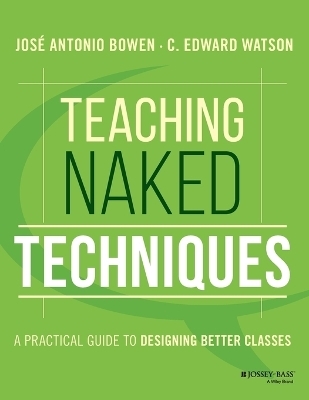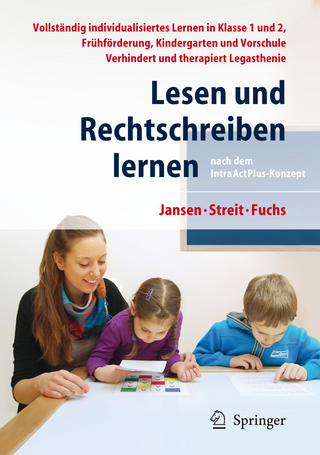
Teaching Naked Techniques
Jossey-Bass Inc.,U.S. (Verlag)
978-1-119-13611-8 (ISBN)
Put Teaching Naked to work in your classroom with clear examples and step-by-step guidance Teaching Naked Techniques (TNT) is a practical guide of proven quick ideas for improving classes and essential information for designing anything from one lesson or a group of lessons to an entire course. TNT is both a design guide and a 'sourcebook' of ideas: a great companion to the award-winning Teaching Naked book.
Teaching Naked Techniques helps higher education faculty design more effective and engaging classrooms. The book focuses on each step of class preparation from the entry point and first encounter with content to the classroom 'surprise.' There is a chapter on each step in the cycle with an abundance of discipline-specific examples, plus the latest research on cognition and technology, quick lists of ideas, and additional resources.
By rethinking the how, when, and why of technology, faculty are able to create exponentially more opportunities for practical student engagement. Student-centered, activity-driven, and proven again and again, these techniques can revolutionize your classroom.
Create more effective, engaging lessons for higher education
Utilize technology outside of the classroom to better engage during class time
Examine discipline-specific examples of Teaching Naked Techniques
Prepare for each class step by step from the student's perspective
Teaching Naked flips the classroom by placing the student's first contact with the material outside of class. This places the burden of learning on the learner, ensures student preparation, and frees up class time for active engagement with the material for more effective learning and retention. Teaching Naked Techniques is the practical guide for bringing better learning to your classroom.
JOSÉ ANTONIO BOWEN is president of Goucher College. He has taught or been an administrator at Stanford University, the University of Southampton (England), Georgetown University, Southern Methodist University, and Miami University. Bowen is a pioneer in active learning and the use of technology in education, including podcasts and online games. His book Teaching Naked: How Moving Technology Out of Your College Classroom Will Improve Student Learning (Jossey-Bass, 2013) is winner of the 2014 Frederic W. Ness Book Award. Bowen has been featured in The New York Times, The Wall Street Journal, Newsweek, USA Today, US News and World Report, and on NPR. He received a Stanford Centennial Award for Undergraduate Teaching in 1990. Bowen is also an international jazz performer and an award-winning composer. C. EDWARD WATSON is director of the Center for Teaching and Learning and Fellow in the Institute for Higher Education at the University of Georgia (UGA). He is the founding Executive Editor of the International Journal of ePortfolio, the Executive Editor of the International Journal of Teaching and Learning in Higher Education, and has published on teaching and learning in a number of journals. He is on the boards of two professional organizations in higher education (AAEEBL & ISETL) and was recently quoted in The New York Times, CNN, NPR, Campus Technology, EdSurge, and University Business Magazine regarding current teaching and learning issues and trends in higher education.
Acknowledgments vii
About the Authors ix
Contributors xi
Introduction: Designing for the Brain in the Body xv
Learning Behaviors: The Brain in the Body xvi
Focus and Motivation xix
Learning and Technology xxi
Pedagogy as Design xxiii
References xxxi
1. Transparency and Clearer Targets 1
Learning Outcomes 2
Rubrics 4
Checklists 7
Advance Organizers 8
Common Language 8
Step‐by‐Step Guide 9
Examples 12
Key Concepts 14
Further Resources 15
References 16
2. Finding Online Content for First Exposure 19
Step‐by‐Step Guide 22
Examples 27
Key Concepts 28
Further Resources 29
References 32
3. Creating Your Own Digital Content 35
Step‐by‐Step Guide 37
Examples 41
Key Concepts 43
Further Resources 43
References 45
4. Instructions and Entry Point 47
Providing Better Instructions 50
Step‐by‐Step Guide 51
Examples 55
Key Concepts 57
Further Resources 58
References 59
5. Online Exams to Improve Student Preparation for Class 61
Grades, Thinking, and Learning 62
Just‐in‐Time Teaching 64
Why Multiple Choice? 64
Feedback 66
Step‐by‐Step Guide 66
Examples 70
Key Concepts 72
Further Resources 73
References 74
6. Preclass Assignments 75
Step‐by‐Step Guide 77
Examples 84
Key Concepts 86
Further Resources 87
References 89
7. Massively Better Classrooms and the Classroom Surprise 91
Step‐by‐Step Guide 93
Examples 104
Key Concepts 106
Further Resources 107
References 109
8. Critical Thinking, Metacognition, and Cognitive Wrappers 111
Step‐by‐Step Guide 115
Examples 121
Key Concepts 123
Further Resources 123
References 125
9. Grading and Feedback 127
Step‐by‐Step Guide 132
Examples 135
Key Concepts 137
Further Resources 137
References 139
10. E‐Communication 141
Multitasking and Student Devices in the Classroom 143
Step‐by‐Step Guide 145
Examples 152
Key Concepts 154
Further Resources 155
References 156
11. Integrated Courses and Sequence 159
Course‐Level Design Process 161
Isolation and Integration 162
Teaching Naked Design Process: Microcycle 165
Step‐by‐Step Guide 167
Examples 171
Key Concepts 174
Further Resources 174
References 175
12. Integrative Learning and Integrated Experiences 177
Common Rubrics 180
The Structure of Majors 182
Introductory Courses 183
E‐Portfolios and Student Retention Software 184
Classrooms and Learning Spaces 185
General Education and Change 186
Step‐by‐Step Guide 193
Examples 195
Key Concepts 197
Further Resources 198
References 199
13. Being a Superhero: Pedagogy as Human Relationships 203
Being Human 204
Avoiding Failure 207
Accepting Failure 210
Embracing Failure and Modeling Change 211
Step‐by‐Step Guide 213
Examples 214
Key Concepts 215
Further Resources 216
References 217
Index 219
| Erscheinungsdatum | 11.02.2017 |
|---|---|
| Verlagsort | New York |
| Sprache | englisch |
| Maße | 213 x 272 mm |
| Gewicht | 612 g |
| Themenwelt | Geisteswissenschaften ► Psychologie ► Pädagogische Psychologie |
| Sozialwissenschaften ► Pädagogik ► Bildungstheorie | |
| ISBN-10 | 1-119-13611-3 / 1119136113 |
| ISBN-13 | 978-1-119-13611-8 / 9781119136118 |
| Zustand | Neuware |
| Informationen gemäß Produktsicherheitsverordnung (GPSR) | |
| Haben Sie eine Frage zum Produkt? |
aus dem Bereich


